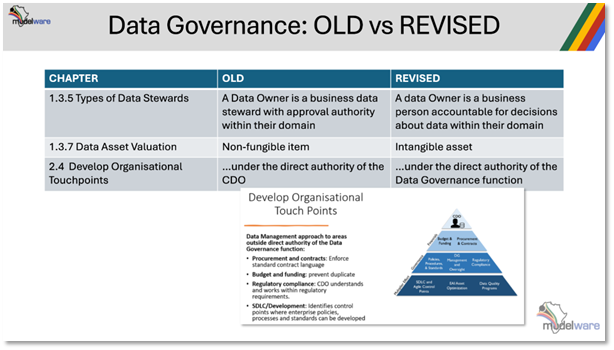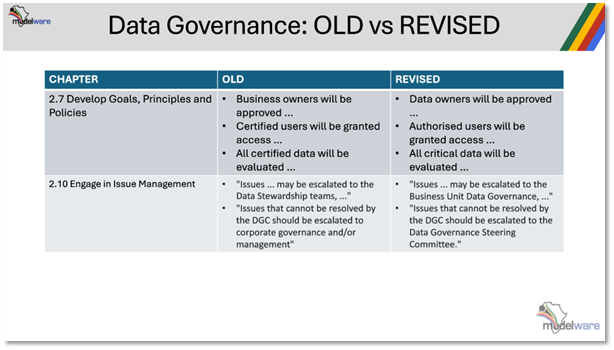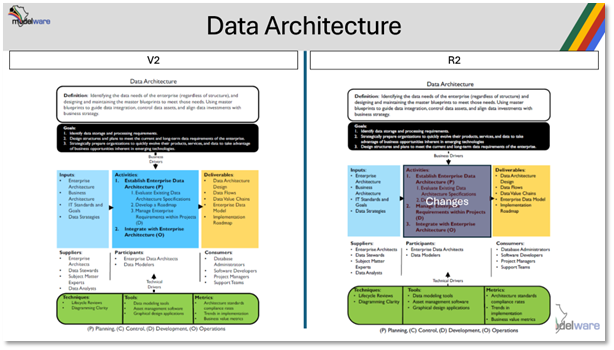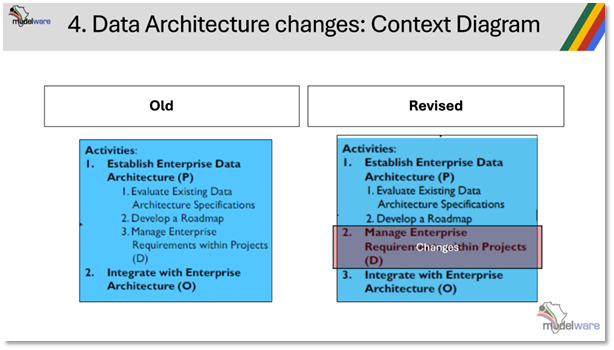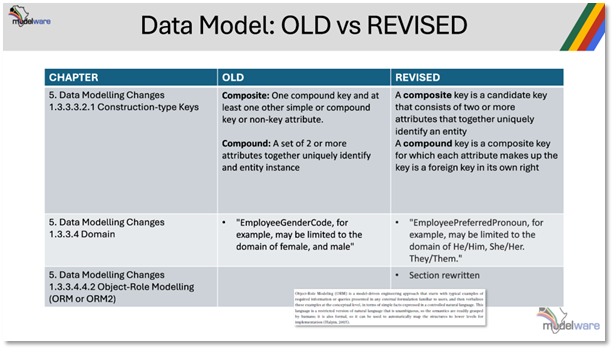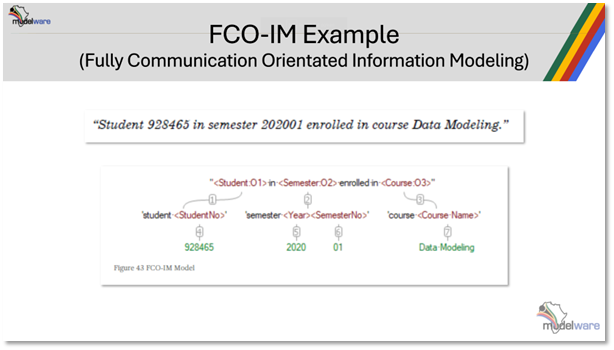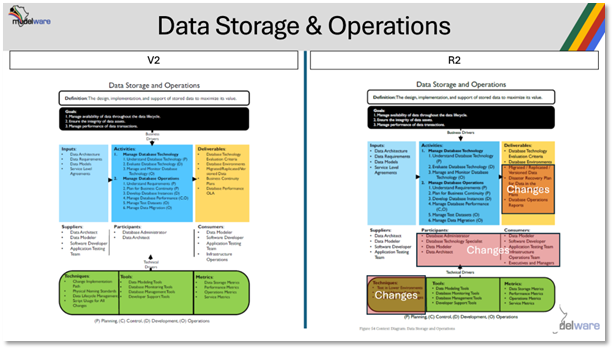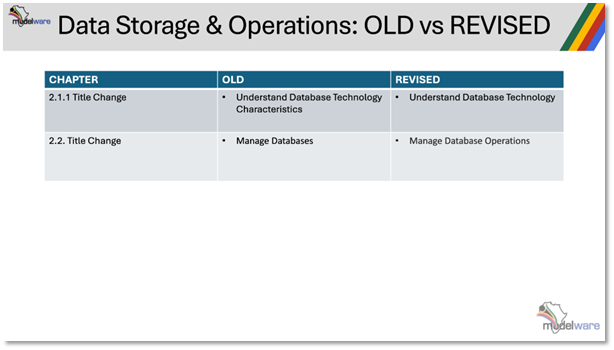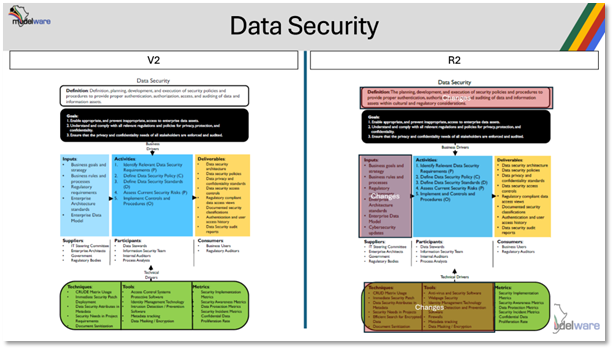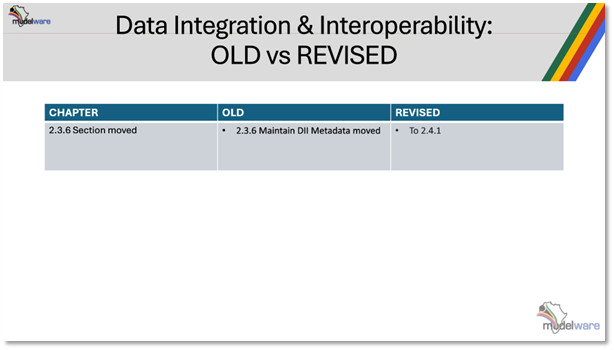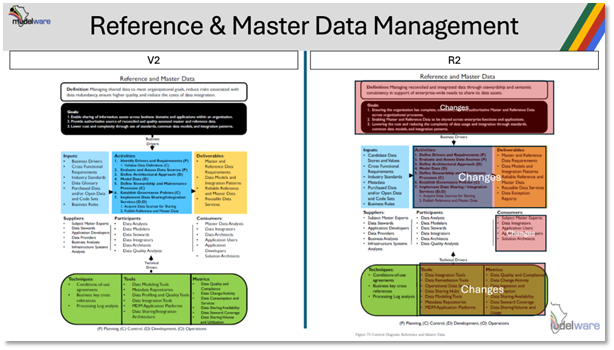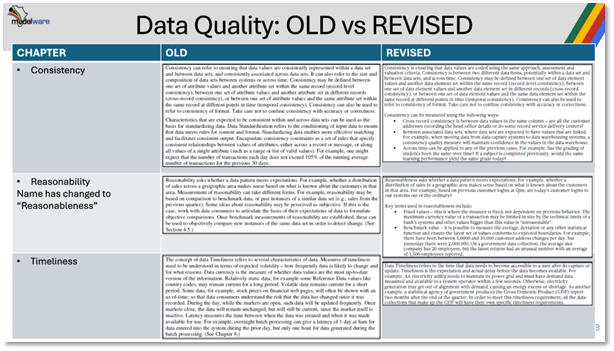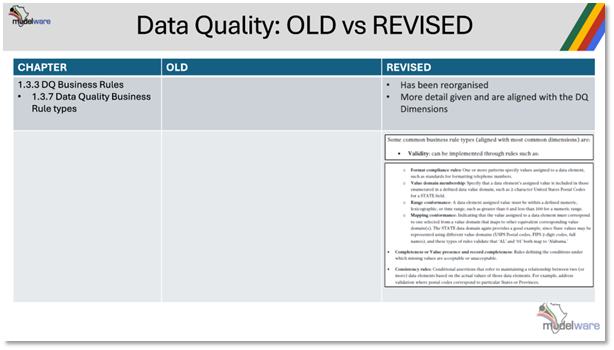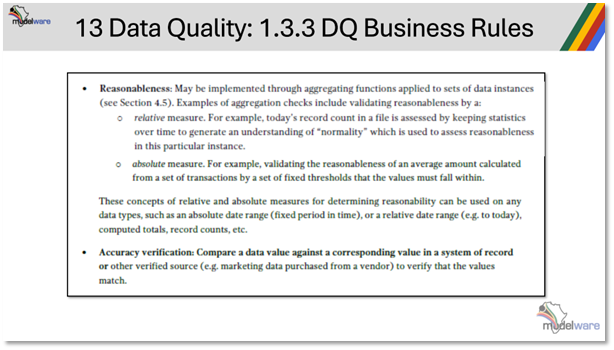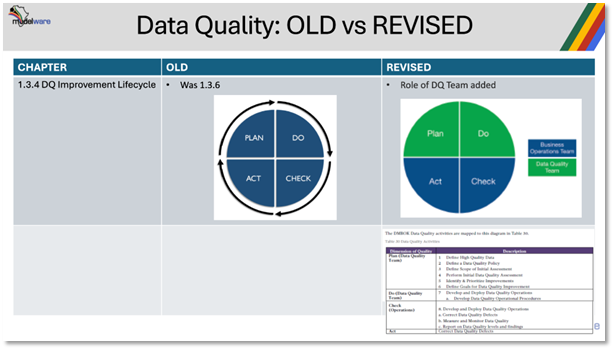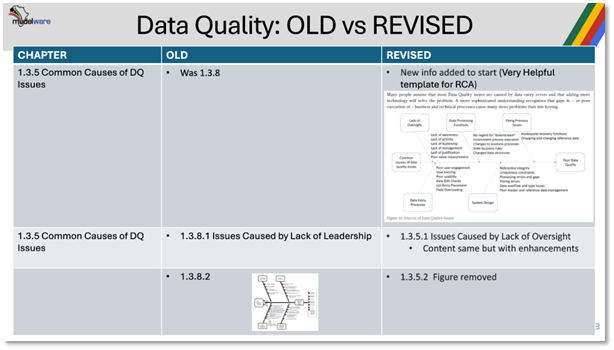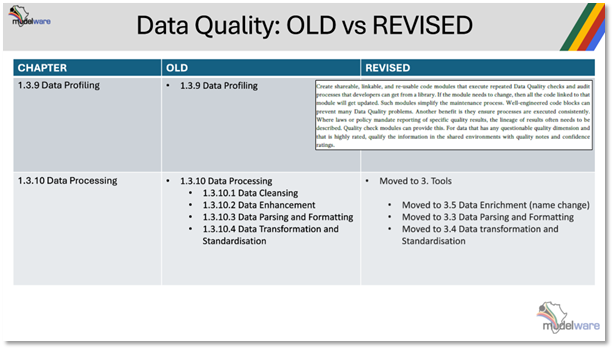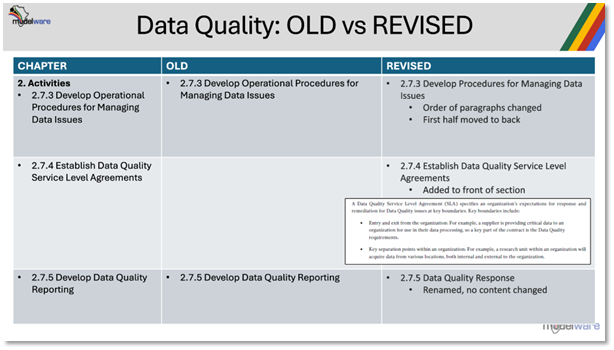Revised Edition Changes to DMBOK v2
Executive Summary
‘DMBOK R2’ highlights the key topics discussed during a virtual meeting on the revised edition of the Certified Data Management Professional (CDMP) exams and the Data Management Body of Knowledge (DMBoK). The meeting covers updates to the DMBoK, data governance, data modelling, professional data management, data quality, metadata management, risk management, big data, and sustainability concerns. Suggestions were made to improve exam questions and align exam answers with the DMBoK’s definitions. Howard Diesel provides valuable insights and learning opportunities for professionals in the field of data management and information technology.
Webinar Details
Title: DMBOK R2
Date: 15 April 2024
Presenter: Howard Diesel
Write-up Author: Howard Diesel
Contents
Executive Summary.
Webinar Details.
Discussion on the Revised Edition of CDMP Exams and DMBOK.
Information on DMBOK and CDMP Certification.
Virtual Meeting Discussion Notes.
Updates to DMBOK and Related Questions.
Data Governance Updates.
Data Governance Council Meeting Notes.
Discussion on Data Governance and Data Architecture.
Data Modeling.
Data Modeling Definitions and Changes.
Professional Data Management and Editing.
Importance of Aligning Exam Answers with DM Book Definition.
Suggestions for Improving Exam Questions.
Data Modeling and System Development
Changes in Data Storage & Operations.
Changes in Data Management Techniques.
Information Architecture and Data Management
Changes in Data Security.
Changes in Data Integration & Interoperability.
Changes in Document & Content Management
Changes in Reference & Master Data Management
Data Warehousing and BI
Data Governance and Metadata Management
Metadata Strategy and Exam Changes.
Data Quality and Strategy Framework.
Revisions in Data Quality Definitions.
Data Quality and Criticality.
Data Governance and Risk Management
Data Quality and Framework Analysis.
Data Quality and Big Data Changes.
Changes in Data Management Maturity Assessment
Data Management and Sustainability Concerns.
Data Quality Assessment and Data Issues.
Change Management Approach and Learning Opportunities.
Discussion on the Revised Edition of CDMP Exams and DMBOK
During the meeting, Howard Diesel announces that the presentation would be made available for feedback to be shared with the VP for development. A mentee has been set up with questions to be managed by Paul, and users will be given login details shortly. Howard highlights that October marks the start of the Certified Data Management Professional (CDMP) exams for the revised edition, and those who have prepared for version one are encouraged to complete preparation for version two. A special offer is available for purchasing the Data Management Body of Knowledge (DMBoK) revised edition PDF version, with a free version two given to those who register before October. Participants are encouraged to purchase the PDF version if interested, as it may not be available for sale anymore.
Figure 1 These are the areas that will be discussed
Information on DMBOK and CDMP Certification
The ethical risk model is introduced as a new technique and announced the publication of a PowerPoint presentation for reference. The discussion revolves around data governance, with Howard asking for audience feedback and coordinating with Paul to collect results. Additionally, updates to DMBoK and related questions will be discussed.
Virtual Meeting Discussion Notes
Howard discusses accessing chapters through a website, highlighting changes in a document's V2 and R2 editions, and introducing the ethical risk model as a new technique. A PowerPoint presentation will be published for reference. Data governance is covered, with Howard requesting feedback from the audience and coordinating with Paul to gather results. A participant interrupts to clarify the input Howard is seeking during the meeting.
Updates to DMBOK and Related Questions
Howard is seeking opinions on the quality and sufficiency of changes made to a specific chapter in DMBoK V2 R2. Some criticism about the chapter's quality has been received, particularly the sections on big data and data science. The latest release of DMBoK V2 is considered a minor upgrade, focusing on corrections and clarifications, for which purchasers will need to pay an additional $10. Discussions about potential upgrades to DMBoK 3 are ongoing, especially regarding the data architecture section. Howard is eagerly waiting for news about the release of the data architecture exam.
Figure 2 Changes in Data Handling Ethics
Figure 3 Menti Results
Data Governance Updates
The recent changes to data governance include defining it for the organisation and the operating model, along with defining a strategy that Howard likes. The definition of a data owner has also been modified to designate a business person accountable for decisions within their domain. Furthermore, AI governance and data ethics, including AI ethics, will now be integrated into data governance. The old concept of data asset valuation as a non-fungible item has been changed to an intangible asset. Lastly, the organisational touchpoints have been revised to state that it is under the direct authority of the data governance function and not the CDO.
Figure 4 Changes in Data Governance
Figure 5 Changes in Data Governance: Definition
Data Governance Council Meeting Notes
The following are the key topics that need to be addressed regarding data management: redefinition of data owners and certified users, evaluation of critical data, issue management and escalation path clarification, business data stewards' responsibilities, adding security and privacy classification to metadata, coordination with architecture groups, and redefining the data asset valuation method as per section 216. It is important to set clear goals, principles, and policies for data management to ensure efficient and secure handling of critical data.
Figure 6 Changes in Data Governance continued
Figure 7 Changes in Data Governance continued
Figure 8 Changes in Data Governance continued
Discussion on Data Governance and Data Architecture
The team recently made some minor changes in data governance, including moving the discussion about managing enterprise requirements within projects to a different section. The Open Group Architecture Framework’s (Togaf) emphasis on managing requirements and allocating them to the appropriate project remains unchanged, with no alterations to deliverables, techniques, and other areas. While there have been some changes to the traditional definition of data architectures, Howard expresses disappointment that the revised edition did not include cloud-native data architectures, which are more relevant today. As a result, the participants agree that this should be considered a version three change and a foundational assumption in today's cloud world. This feedback is suggested to be added to the mentee for further discussion.
Figure 9 Changes in Data Architecture
Figure 10 Changes in Data Architecture: Context Diagram
Data Modeling
Data modelling is an essential aspect of data management, and it involves several elements, such as business glossary support, domain vocabulary, and engineering types. Conceptual, logical, and physical data models are crucial in data modelling design and are represented through diagrams that vary in levels, schemes, and notations. It's equally important to record definitions, lineage, and issues in data modelling. The choice of notations, such as Information Engineer (IE) or Unified Modelling Language (UML), is also significant. Two versions of data modelling books are currently in use, V2 and V2 R2, and they offer detailed information about data architecture and modelling. Finally, the book's release and timeline for exams are eagerly anticipated.
Data Modeling Definitions and Changes
Howard discusses the availability of the V2 R2 DMBoK and its contents related to data integration techniques, data modelling, and composite keys. However, he expresses uncertainty regarding including canonical modelling in the book. Additionally, Howard highlights a change in the definition of composite and compound keys, which raises concerns about the book's accuracy.
Figure 11 Changes in Data Modeling
Figure 12 Changes in Data Modeling continued
Professional Data Management and Editing
The possibility of publication errors is mentioned during a discussion on the data management section. The conversation highlights the need for quicker correction and publication of errata to prevent people from holding onto incorrect information, especially before exams. Participants acknowledge the effort put into refining data management materials but also discuss the challenges of detecting errors in one's own work. The importance of having precise editors is emphasised.
Importance of Aligning Exam Answers with DM Book Definition
The significance of aligning exam answers with the Data Management Body of Knowledge (DMBoK) definition is highlighted, irrespective of whether the practised methods are right or wrong. Participants discuss whether conformity to DMBoK in exam answers implies that practice methods are irrelevant. The need to conform to the DMBoK versions of the definition, especially in exams, is emphasised. Personal experience is shared about falling into the trap of prioritising practised methods over the DMBoK definition. Howard notes that professionals may struggle more than those unfamiliar with DMBoK in accepting and conforming to its definition. Lastly, the importance of answering exam questions in alignment with the DMBoK's definition is emphasised while acknowledging the difficulty in coordinating a body of knowledge with multiple authors for V3 of the DMBoK.
Suggestions for Improving Exam Questions
Howard covers various aspects related to exam content, such as the use of DMBoK content and avoiding personal opinions, the importance of question reviews and psychometric analysis to improve the quality of exam questions, the need for standardised rules for true or false questions, and the significance of inclusivity concerning preferred pronouns. Howard also mentions the rewriting of the object role modelling section of the exam, the introduction of FCO as a component of the exam content, the contribution of a diagram by Marco Woben, and the presentation of the updated version of employee preferred pronouns for review.
Data Modeling and System Development
The course on data modelling focuses on structuring and modelling data, with major changes in data storage and operations. Guidelines for exam setting are to be avoided, while a disaster recovery plan for data is emphasised with a focus on database operation reports. Title changes in various sections, such as understanding database technology and managing database operations, are covered. Additionally, the section on data security has been updated with a title change and relocation of web page security to a different section. Lastly, the changes emphasise data integration and interoperability definitions, focusing on managing the movement and consolidation of data within and between applications.
Figure 13 FCO-IM Example (Fully Communication Orientated Information Modeling)
Changes in Data Storage & Operations
Figure 14 Changes in Data Storage & Operations
Figure 15 Changes in Data Storage & Operations continued
Changes in Data Management Techniques
Recent changes in the data industry have shifted from data latency to data availability and improvements in time to market for enhancements. Security measures have been completed, and the focus on maintaining metadata has shifted to a new section. Additionally, a Content strategy has been expanded to include content handling policies and a defined content information architecture, addressing previous gaps in understanding information architecture as it relates to documents and content.
Information Architecture and Data Management
Various topics relating to information architecture, document and content architecture, reference and master data management, and data warehousing are covered. Howard includes changes in the Data Management Body of Knowledge (DMBOK) from version one to version two, particularly regarding architecture and different knowledge areas. He discusses removing "validate data definitions" from the data management approach and the rationale for standardising data and changes in policies and procedures in the data management approach. He changes from "ingestion and consumption" to "data consumption and services" in the data management approach. Finally, Howard covers the inclusion of journey maps as part of deliverables.
Changes in Data Security
Figure 16 Changes in Data Security
Figure 17 Changes in Data Security continued
Changes in Data Integration & Interoperability
Figure 18 Changes in Data Integration & Interoperability
Figure 19 Changes in Data Integration & Interoperability continued
Changes in Document & Content Management
Figure 20 Changes in Document & Content Management
Changes in Reference & Master Data Management
Figure 21 Changes in Reference & Master Data Management
Data Warehousing and BI
Participants discuss data warehousing and business intelligence, focusing on data lineage and the concept of a lineage dictionary. Howard expresses disappointment about removing customer and user satisfaction from the discussion, highlighting the importance of customer feedback in data reporting. Additionally, the importance of seeking customer feedback in any data-related initiatives or projects is emphasised, as customer satisfaction is applicable across various data products, not limited to data warehousing and BI.
Figure 22 Changes in Data Warehousing and Business Intelligence
Figure 23 Changes in Data Warehousing and Business Intelligence continued
Data Governance and Metadata Management
The data governance section emphasises collaboration and engagement with the user community, focusing on creating insights to support effective business analysis and decision-making. However, there is a disparity in the perception of users using reports compared to data quality and governance metrics, which carry weight in decision-making. Feedback from a customer with 2500 reports highlights the challenges of maintaining and navigating the reporting landscape, leading to dissatisfaction and time-consuming efforts. Changes in the context diagram reflect a change from audit data that can be queried to queriable data, prompting confusion and the possibility of a missing word. Input on metadata management changes and potential missing elements at the bottom of the section is requested.
Figure 24 Changes in Metadata Management
Figure 25 Changes in Metadata Management continued
Metadata Strategy and Exam Changes
Metadata repository activities and measuring engagement, collaboration, and other activities are discussed. The definition of metadata has been expanded to include planning, implementation, and control activities. Veronicas resolves an error in the Federation diagram, while discussions were held on the meaning of "other data" in metadata strategy. Challenges were encountered in defining metadata and other data. It is clarified that exam changes would only affect those taking the exam in October 2024 and onwards. Completing the exam quickly using the current version of the DMBoK is recommended.
Data Quality and Strategy Framework
During the review ‘metadata,’ Howard notes errors in figures 85 and 87. However, the proposed changes were not made. Additionally, the data quality section needs to be addressed and enhanced, with concern over removing "strategy" from the data quality framework. Howard notes a mistake of removing “strategy” from the activity list, but it is left in the deliverables. There is an ongoing discussion regarding the importance of defining high-quality data and the need for an acceptable quality standard within the organisation.
Revisions in Data Quality Definitions
In a discussion about data quality, Howard suggests that data can be acceptable or unacceptable, and there is no in-between. The definition of "fit for use" is contextual and dependent on the data consumer's needs. A new concept of "fit for use" has been introduced to upgrade data quality definitions and high-quality, certified, and remediated data. A data asset is defined as certified and curated data that is ready for use. Howard identifies changes and shifts from a governed approach to a systematic approach to data quality, expressing a preference for the latter.
Figure 26 Changes in Data Quality
Figure 27 Changes in Data Quality: Introduction
Figure 28 Changes in Data Quality continued
Figure 29 Changes in Data Quality continued
Figure 30 Changes in Data Quality continued
Figure 31 Changes in Data Quality continued
Figure 32 Changes in Data Quality continued
Figure 33 Changes in Data Quality continued
Figure 34 Changes in Data Quality continued
Figure 35 Changes in Data Quality continued
Figure 36 Changes in Data Quality Business Rules
Figure 37 Changes in Data Quality Business Rules continued
Data Quality and Criticality
Howard highlights changes made to the data quality section, the significance of defining master data and critical data elements, the importance of clarity in defining dimensions, the use of critical data elements in data quality and protection, and the document's failure to address data risks and their impact on business. The changes include the removal of section 1.3.1 data quality and the addition of critical data elements. It is essential to define master data and critical data elements to ensure data quality and protection. Additionally, clarity in defining dimensions is crucial. Critical data elements play a vital role in data quality and protection. However, the document lacks discussion on data risks and their impact on business.
Data Governance and Risk Management
Howard notes that Mark Atkins and Terry Smith's book, ‘Data Governance Needs Risk Management,’ emphasises the importance of integrating data governance and risk management. The book provides definitions of accuracy, completeness, consistency, integrity, reasonableness, timeliness, uniqueness, and validity in the context of data governance for the DQ specialist exam. The focus on the defined domain of values and data currency is highlighted in the discussion of data quality business rule types. Additionally, changes in the implementation framework, including the addition of the data quality team, are noted for their helpfulness in addressing emerging issues.
Data Quality and Framework Analysis
Howard discusses the use of fishbone diagrams for root cause analysis and remediation. He also highlights issues related to the lack of data management sponsorship and ownership. He provides examples of data quality issues, system design, and common causes of DQ issues in the CDMP exam. Howard emphasises considerations for data modellers and application developers in fixing issues, the movement of essential concepts to tools such as data enrichment, pairing tools, and transformation, and defining and implementing a data quality framework to organise and leverage data quality tools. Finally, Howard stresses the importance of prioritising critical data and supporting business rules when analysing data quality dimensions.
Figure 38 Changes in Data Quality continued
Figure 39 Changes in Data Quality continued
Figure 40 Changes in Data Quality continued
Figure 41 Changes in Data Quality continued
Figure 42 Changes in Data Quality continued
Figure 43 Changes in Data Quality: Activities
Figure 44 Changes in Data Quality continued
Figure 45 Changes in Data Quality continued
Figure 46 Changes in Data Quality: 2.7.2 Measure and Monitor Data Quality
Figure 47 Changes in Data Quality continued
Figure 48 Changes in Data Quality continued
Figure 49 Changes in Data Quality continued
Figure 50 Changes in Data Quality continued
Figure 51 Changes in Data Quality continued
Figure 52 Changes in Data Quality continued
Figure 53 Changes in Data Quality continued
Figure 54 Changes in Data Quality continued
Figure 55 Changes in Data Quality continued
Data Quality and Big Data Changes
The data quality process has been enhanced with a focus on completeness, uniqueness, timeliness, and validity. Implementation guidelines suggest cultural changes and their impact on other areas, while the ISO standard 8,061 is crucial for data quality, big data, and data science. Changes in the Big Data environment and communication with stakeholders have been established, and model performance and techniques have been updated along with changes in the Data Management Maturity Assessment (DMMA). Suggestions for version three include identifying critical data elements, KPIs, business process metrics, and business risks. The CDMP exam can use the current DMBOK book version two until October.
Figure 56 Changes in Big Data and Data Science
Changes in Data Management Maturity Assessment
Figure 57 Changes in Data Management Maturity Assessment
Data Management and Sustainability Concerns
During a discussion, one participant suggests that the revised edition of a text offers a clearer explanation. Howard expresses his concern over the lack of talk about sustainability in data governance and management, particularly the absence of reference to "green data management." The same participant also raise the issue of whether the text covers aspects of auto-profiling and auto decision-making in Big Data science. Howard notes that while there is a section on data quality in Big Data, it does not adequately address the challenges posed by factors like velocity and veracity.
Data Quality Assessment and Data Issues
Data quality issues can arise during various stages of data management, such as data entry, Extract-Transform-Load (ETL), consolidation, and transformation. Data decay is a common problem during data migration, where stale data accumulates and demands attention. A thorough data quality assessment and review should be conducted before data migration to prevent the transfer of inaccurate or corrupt data. However, Howard notes that people tend to avoid addressing data quality concerns due to fear of management backlash. Careful communication and change management techniques are required to ensure successful data quality assessments and data management maturity assessments.
Change Management Approach and Learning Opportunities
Change management is a crucial aspect of successful business operations. It is important to discuss any changes to the operating model with the CIO and business heads before announcing them. Additionally, involvement in preparing Data Management (DM) content and sharing experiences and challenges can help ensure a smooth transition. Finally, learning opportunities can be found through contributing, teaching, and writing about topics related to change management.
If you want to receive the recording, kindly contact Debbie (social@modelwaresystems.com)
Don’t forget to join our exciting LinkedIn and Meetup data communities not to miss out!







